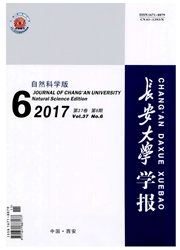

 中文摘要:
中文摘要:
为了运用地学方法对公路泥石流危险性进行评价,建立了泥石流沟不同地貌演化阶段与泥石流灾害规模、频率的关系,构建了泥石流沟不同演化阶段与泥石流灾害危险性等级之间的映射关系,据此进行公路泥石流灾害危险性评价。以横断山区美姑河流域公路泥石流为例,从区域新构造应力场、泥石流物源和气象条件3个方面分析了泥石流灾害发育的宏观规律,并应用泥石流沟发育阶段与泥石流灾害危险性等级的映射关系评价美姑河流域沿河公路泥石流灾害危险性。研究结果表明:泥石流沟谷地貌的整个演化过程中,在壮年偏幼年期泥石流灾害危险性等级最高,各发育阶段按泥石流灾害危险性大小由高到低排序为壮年偏幼、壮年、幼年、壮年偏老、老年;横断山区美姑河流域公路泥石流沟77.5%处于危及公路地质安全的状态。
 英文摘要:
英文摘要:
Based on the relationships between evolution stage of debris flow gully and disaster scale, frequency, and hazard level, highway debris flow hazard can be assessed. The macro-law of forming debris flow disaster in Meigu river basin was analyzed from the perspective of regional new tectonic stress field.material sources and meteorological conditions. The established relation- ship between evolution stage of debris flow gully and debris flow hazard level was applied to the highway debris flow hazard assessment for Meigu river. The results show that in strong-to-young stage the debris flow gully has the highest hazard level, and the rank of hazard level in life cycle of debris flow gully from high to low is strong-to-young, strong, young, strong-to-old and old. 77.5% of the debris flow gullies along Meigu river highway are in the state of endangering high- way geology security.
 同期刊论文项目
同期刊论文项目
 同项目期刊论文
同项目期刊论文
 期刊信息
期刊信息
